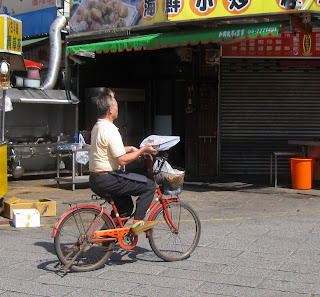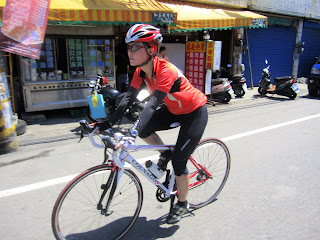
Thursday, September 30, 2010
Vote For Su Chia Chuan 蘇嘉全... He Rides A Salsa La Cruz CX Bike

What Is Taiwan's Biggest Bike Market?
Wednesday, September 29, 2010
Travelist: Vote For Taiwan Cycling Route
Distance: 50km/31mi.
Max Speed: 50kph/31mph
Average Speed: 32kph/20mph
Tuesday, September 28, 2010
Taiwan Tourism and Economic Cycles
President Ma Ying-jeou said Saturday that the number of visitors in Taiwan is expected to reach a record 5.2 million this year, mainly because improved cross-strait relations have brought more Chinese tourists.
In the latest edition of his online video journal, Ma defended his administration's policy of allowing more Chinese tourists.
"I think I am doing the right thing, so I will continue to do it and not be afraid of criticism"
Lai attributed the steep rise to airlines increasing the number of flights between Taiwan and Malaysia. She also said many Malaysian tourists preferred to travel without tour groups, staying in guest houses or riding bicycles.
She said the Tourism Bureau planned to promote the Lantern Festival in the spring, local cuisine in the summer, cycling in the fall and hot springs in the winter.
- Virginia learns the cerebral joys of riding solo: here
- Videos from the Cyclocross USGP: here
- Allen Lim, the sports physiologist for Lance Armstrong and Floyd Landis will testify (Oh please let me go to great lengths to give Taiwan ownership of him ala Michael Chang.... Lim's parents fled China at different times and met in the Philippines, then moved to Taiwan, before moving to L.A. where Allen is from. Pride of The Nation... LOL!!!): here
- Just the good ole' boys... and they mean us some harm! Kentucky driver seeks to harm cyclists: here
Sunday, September 26, 2010
Cycling's Ultra-Man DEAD: 5 Time RAAM Winner Jure Robic Killed In Tragic Accident
UCI Road World Championships

Saturday, September 25, 2010
明德水庫 Mingde Reservoir Century: 190km/119mi


Friday, September 24, 2010
Crank Arm Length and Efficiency

I recently came upon this wonderfully wonky blog that focuses more on competitive cycling and how to record rides for posterity... but it also has a lot of useful information for any cyclist. This topic on crank arm length and efficiency is particularly interesting. One important note is to remember that efficiency and speed do not necessarily correspond. So when the study says 1:60 RPM is the most efficient cadence, that does not mean it is the fastest.
Thursday, September 23, 2010
Temple Politics: The Lanterns of Lukang
Moreover, the temple can demonstrate its importance and access to the real power to make things happen that can bring benefit and prosperity to the loyal and the faithful. While the gods are given the authority to bestow luck, change fates, interfere in daily life and secure fortunes in the abstract, the modern Taiwanese politician has the power to make these prayers a reality in exchange for electoral devotion. The politician can control zoning, attract investment, and resolve disputes. At the higher levels politicians also have the ability to influence the outcome of court cases. Politicians offer a real and imagined blanket of security in the mortal world and the Tian Ho Temple is keen to align itself with those who currently hold power. I am aware of several instances where a temple works in conjunction with a local politician for mutual gain. The politician patronizes the temple and brings adherents (who will buy incense, offerings, supernatural favors etc...) and in exchange the spirit medium at the temple will send troubled adherents to the politician for resolution and thus owing the politician his patronage.

Lien Chan's Couplet
In the case of the Tian Ho Temple, the ruling KMT party is clearly entrenched. Temples also serve as points to mobilize political support and many are said to serve as undeclared streams of revenue that flow into party coffers.
With such social and political forces at play within the temple walls, it is no surprise that organized crime syndicates are said to be heavily involved in the operation and mobilization of the temple's economic and political capital. Temples [may] serve as rallying points for organized crime bosses in which politicians can come into open contact with the figures who control several of Taiwan's most important industries.
Beyond the main hall of the temple lies a small court yard. At some point in recent history someone decided to paint a mural in dedication to the temple of origin in Fujian, China. At first glance this may appear to promote and symbolize a close relationship to the authenticity found in China; a major trope promoted by the KMT in over 60 years of ROC rule in Taiwan. The KMT has always sought to push China to the fore of the Taiwanese imagination as a much closer place than it actually is. Most Taiwanese have never been to China and, only after decades of ideological education, conceive of it as an abstract place of imagined ethnic origin, which may not be exactly the case as I argue here.
Over the course of Taiwan's experience between Dutch, Cheng, Qing, Japanese, KMT and democratic government structures and changing motivations of these structures, the Taiwanese temples have also changed-- if not in shape then in meaning. The importance of the temple and its function in society has not been fixed, but it has always been in a constant state of dynamic change and renegotiation to adapt to contemporary Taiwanese life and fulfill a multitude of purposes.

During the vast liberalization policies of the Lee Teng-hui administrations, Taiwanese were free to openly reinterpret the symbols and meanings of their land and the symbols presented to them by the authoritarian KMT regime. The economic boom of the 1990's, which coincided with vast democratic reforms, allowed new understandings of Taiwanese life and Taiwanese felt free to question their official historical narratives. Taiwanese sought new venues to reframe their world and adjust to the reality of how they viewed themselves and how they viewed Taiwan.
The role of the temple as a public center was also opened up to encompass local awareness, particularity and history. The sign above tells the story of Lukang, beginning with Plains Aborigines. This is especially important as it seems to intentionally deviate from the old Chinese nationalist trope that often begins with Han immigration to Taiwan and other Han-centric mythologies that frame Taiwan as a periphery of China.
For many decades research into plains aboriginal culture and history was discouraged in favor of a "greater China" view that sought to obscure the Austronesian contribution to Taiwan in favor of Taiwan as part of the Han-Chinese racial nation.



Wednesday, September 22, 2010
Moon Cycles: Mid-Autumn Festival Ride (55mi./89km.)

Tuesday, September 21, 2010
World Car Free Day September 22
Every September 22, people from around the world get together in the streets, intersections, and neighbourhood blocks to remind the world that we don't have to accept our car-dominated society.
But we do not want just one day of celebration and then a return to "normal" life. When people get out of their cars, they should stay out of their cars. It is up to us, it is up to our cities, and our governments to help create permanent change to benefit pedestrians, cyclists, and other people who do not drive cars.
Let World Carfree Day be a showcase for just how our cities might look like, feel like, and sound like without cars…365 days a year.
As the climate heats up, World Carfree Day is the perfect time to take the heat off the planet, and put it on city planners and politicians to give priority to cycling, walking and public transport, instead of to the automobile.
Monday, September 20, 2010
Back In Business: Night Riding and Training Notes.
- Lance Armstrong is a drug cheat... and there is an audio recording to prove it.
- The kids are all right! America's future in cycling looks bright with Ben King and Taylor Phinney.
- Italy's rising star Nibali takes Vuelta. This guy looked great during the Giro and now takes the Vuelta.
- Cycling is set for another bid at the Hollywood treatment. Trailer. Other biking movies: here
- Floyd Landis is angry at somebody else... again.
- More on the benefits of cycling.
- Insights on long distance utility cycling.
- Part III of Joe Friel's valuable study on the effects of aging on cycling performance.





























